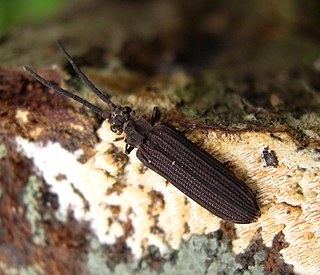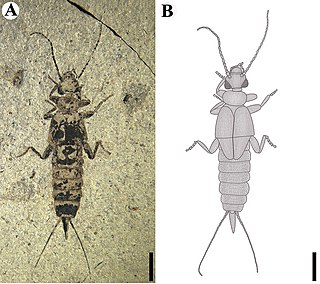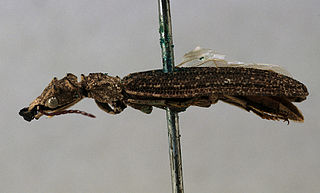
The Cupedidae are a small family of beetles, notable for the square pattern of "windows" on their elytra, which give the family their common name of reticulated beetles.

The Trachypachidae are a family of beetles that generally resemble small ground beetles, but that are distinguished by the large coxae of their rearmost legs. There are only six known extant species in the family, with four species of Trachypachus found in northern Eurasia and northern North America, and two species of Systolosoma in Chile and Argentina. They were much more diverse in the past, with dozens of described species from the Mesozoic.

The Cerophytidae are a family of beetles belonging to Elateroidea. Larvae are associated with rotting wood, on which they are presumed to feed. The family contains over 20 species in five genera, primarily distributed in the New World, but also in Eurasia and Africa. 17 fossil species in 7 genera are known extending to the Early Jurassic. Like some other elateroids, the adults are capable of clicking.

Bittacidae is a family of scorpionflies commonly called hangingflies or hanging scorpionflies.

Anaxyelidae is a family of incense cedar wood wasps in the order Hymenoptera. It contains only one living genus, Syntexis, which has only a single species, native to Western North America. Fossils of the family extend back to the Middle Jurassic, belonging to over a dozen extinct genera, with a particularly high diversity during the Early Cretaceous. Syntexis lay eggs in the sapwood of conifers, preferring recently burnt wood.

Nemonychidae is a small family of weevils, placed within the primitive weevil group because they have straight rather than geniculate (elbowed) antennae. They are often called pine flower weevils. As in the Anthribidae, the labrum appears as a separate segment to the clypeus, and the maxillary palps are long and projecting. Nemonychidae have all ventrites free, while Anthribidae have ventrites 1-4 connate or partially fused. Nemonychidae lack lateral carinae on the pronotum, while these are usually present, though may be short, in Anthribidae.

Protodiplatyidae is an extinct family of earwigs. It is one of three families in the suborder Archidermaptera, alongside Dermapteridae and Turanovia. Species are known from Jurassic and Early Cretaceous fossils and have unsegmented cerci and tarsi with four to five segments.

Coptoclavidae is an extinct family of aquatic beetles in the suborder Adephaga. The Coptoclavidae lived from the Late Triassic to the Early Cretaceous. Coptoclavidae is a member of the adephagan clade Dytiscoidea, which contains other aquatic beetles. Suggested reasons for their extinction to include the rise of teleost fish, or competition with Gyrinidae and Dytiscidae, which possess defensive secretions and sucking channels in the mandibles of larvae, which coptoclavids likely lacked. It has been suggested that the genus Timarchopsis and the subfamily Timarchopsinae are only distantly related to other coptoclavids based on cladistic analysis, with Timarchopsis being more closely related to geadephagans like carabids and trachypachids instead. Another study also suggested similarly for Coptoclavisca and possibly other coptoclaviscines.
Protorabinae is an extinct subfamily of beetles in the family Carabidae. It contains 36 species in 13 genera, all extinct.
Palaeodytes is an extinct genus of beetles in the family Dytiscidae, containing the following species:
Mesogyrus is an extinct genus of fossil beetles in the family Gyrinidae, containing the following species:

Cionocoleus is an extinct genus of beetles in the family Ommatidae.

Omma is a genus of beetles in the family Ommatidae. Omma is an example of a living fossil. The oldest species known, O. liassicum, lived during the final stage of the Triassic (Rhaetian), over 200 million years ago, though the placement of this species in Omma has been questioned. Numerous other fossil species are known from the Jurassic and Cretaceous of Europe and Asia. The only living species is Omma stanleyi, which is endemic to Australia. Three other extant species endemic to Australia that were formerly part of this genus were moved to the separate genus Beutelius in 2020.Omma stanleyi is strongly associated with wood, being found under Eucalyptus bark and exhibiting thanatosis when disturbed. Its larval stage and many other life details are unknown due to its rarity. Males are typically 14–20 mm in length, while females are 14.4-27.5 mm. Omma stanleyi occurs throughout eastern Australia from Victoria to Central Queensland.

Tetraphalerus is a genus of beetles in the family Ommatidae, It is currently known from two extant species native to South America and several fossil species from the Jurassic and Cretaceous of Asia.
Locustopsidae is an extinct family of grasshoppers in the order Orthoptera. There are about 17 genera and more than 60 described species in Locustopsidae.

Eremochaetidae is an extinct family of brachyceran flies known from the Jurassic and Cretaceous periods of Asia. It is part of the extinct superfamily Archisargoidea. The morphology of the ovipositor of the only 3 dimensionally preserved genus Zhenia was initially interpreted as evidence of being an endoparasitoid of arthropods, however a subsequent study suggested that the ovipositor was used to deposit its eggs in plant material, similar to members of Tephritoidea. In a phylogenetic analysis, Ermochaetidae was found to be monophyletic, surrounded by a paraphyletic Archisargidae.

Archisargidae is an extinct family of brachyceran flies known from the Jurassic and Cretaceous periods. It is part of the extinct superfamily Archisargoidea. Most members of the family are known from the Callovian-Oxfordian Daohugou biota of Inner Mongolia, China, and the equivalently aged Karabastau Formation of Kazakhstan. The family has been found to be paraphyletic with respect to Eremochaetidae in a cladistic analysis.
Praeaulacidae is an extinct family of Mesozoic parasitic wasps in the suborder Evanioidea. It among the earliest known families of the group and is characterised by more complete wing venation in comparison to other members of the suborder. It has been found that Othniodellithidae is nested within Praeaulacidae via cladistic analysis.
Mesochrysopidae is an extinct family of lacewings known from the Jurassic and Cretaceous periods. They are considered to be closely related to green lacewings of the family Chrysopidae. The family are also alternatively considered a paraphyletic grade leading up to crown Chrysopidae.

Orthophlebiidae is an extinct family of scorpionflies known from the Triassic to Cretaceous, belonging to the superfamily Panorpoidea. The family is poorly defined and is probably paraphyletic, representing many primitive members of Panorpoidea with most species only known from isolated wings, and has such been considered a wastebasket taxon.














